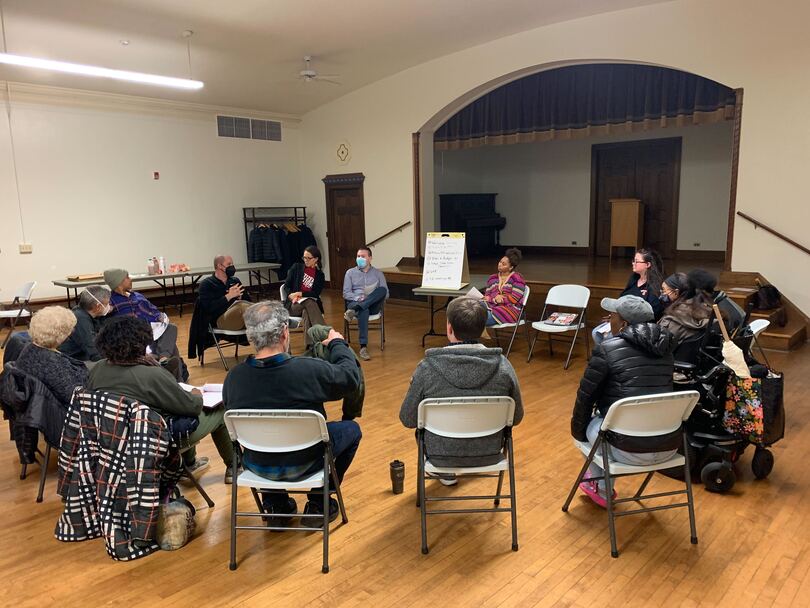Residents use teach-in to learn about truth of NY politics, healthcare inequality

Nearly 20 Syracuse residents Tuesday at the Beauchamp Branch Library for a community teach-in on healthcare inequality in New York state. Dom Chiappone | Staff Writer
To support student journalism and the content you love, become a member of The Daily Orange today.
Carole Resnick has lived in Syracuse and been an active community member in New York state for over 40 years, but she still doesn’t know how the state’s government really works.
“I have decades of activist experience, and I know nothing about legislative work,” Resnick said. “It’s really hard to just catch on as you go, which is what I’ve been trying to do. I care a lot about healthcare issues.”
Resnick, a former member of the Syracuse Peace Council, joined nearly 20 other Syracuse residents Tuesday at the Beauchamp Branch Library for a community teach-in on healthcare inequality in New York state, as well as general state politics and government functions. Syracuse Democratic Socialists of America members Joe Bennett and Ursula Rozum moderated the forum, and several participants represented local advocacy groups, including Citizen Action of New York, CNY Solidarity Coalition and Occupy Syracuse.
Resnick emphasized the importance of transparency between government and constituents.
“The state is slow and not attentive to what people actually need,” Resnick said. “It’s really determined by the power-holders and not necessarily by the representatives equally.”
Rozum, also a member of Citizen Action of New York, said it’s important to understand how the state government functions because it has a broader reach than local governments and handles the state budget.
Rozum and Bennett explained state political dynamics, like the current breakdown of the state assembly and senate, the aftermath of the 2022 midterm elections, Gov. Kathy Hochul’s current positioning in the state’s politics and ways for state residents to communicate with their representatives.
“It’s very important to host events like this so that community members can feel empowered and confident that they can engage with the state legislative process,” Rozum said. “Our government exists to work for all of us.”
Resnick said that although she is still learning about how the New York government functions, she said she finds it difficult to maintain trust in the system when politicians are motivated by “power, money and dirty dealing.”
Charles Hudson, who works as a healthcare provider for AccessCNY, said he has to balance his job with also being a student and caretaker for his mother, Agnes McCray, who has cerebral palsy. He said he’s advocating for raising the current minimum wage for healthcare workers to $22.50 per hour.
In 2020, the average New York state healthcare worker made only $15.93 per hour, according to a study from the City University of New York.
Rozum described Syracuse as a “medical debt hotspot.” According to the Urban Institute debt mapping project from Feb. 2022, Onondaga County was tied for the third-most medical debt, with 14% of the population having medical debt in collection, or when an overdue medical bill is sent to a debt collection agency.
For communities of color, medical debt in collection spiked to 26 percent. Only 6 percent of New York’s population has medical debt in collection and just 5 percent for communities of color, according to the same mapping project.

“Like many economic justices and injustices, we know that this is something impacting communities of color more than white communities, but it impacts everybody,” Rozum said.
When Rozum asked the group if anyone had been harassed by collection agencies, nearly half the participants raised their hand. Rozum saie medical debt in collection is “horrible,” but common across Syracuse.
“What we want to do is build a movement of patients that are willing to pressure our elected officials and get them to hold hospitals accountable,” Rozum said.
Rozum said Crouse Hospital is one of the biggest culprits in targeting patients who can’t afford to pay back their bills.
According to a Mar. 2022 report from the Community Service Society, Crouse Health Hospital filed 5,546 lawsuits between 2015 and 2019, the most out of any hospital in New York. Onondaga County filed the third highest number of lawsuits against patients between 2015 and 2019 for failure to pay back medical debt. Statewide, the Community Service Society of New York reported that hospitals sued over 53,000 people over unpaid bills between 2015 and 2020.
In a March 2022 poll, 73% of New Yorkers said they want assistance to pay their medical bills.
McCray, who attended with her son, said state residents should do research which representatives sponsor what bills, especially involving health care and other local concerns.
“The more voices we have, the more we find out,” McCray said. “Who does the politician listen to?”
McCray said voting and civic collaboration are important in holding politicians accountable, especially when healthcare legislation fails to reach the voting stage at the state level despite popular support.
Several members of the group brought up the New York Health Act. The bill, sponsored by state Sen. Gustavo Rivera (D-N.Y.) and 34 other Democratic state senators, would establish a universal single-year health plan in New York state.
Despite having a Democratic majority in both the state assembly and senate, State Assembly Speaker Carl Heastie and State Senate Majority Leader Andrea Cousins didn’t bring the law up for a vote out of fear that voters from swing districts would be turned off by a state Medicare for All policy, Rozum said.
Leeandra Torrance, a Southside resident and one of the event’s participants, said setting up these types of discussions is hard work, but that they are valuable in the long-run for the local community.
“You have to do a lot of work to teach people about it, educate people about it, and bring awareness about it,” Torrance said. “It takes time, and we’re willing to do the work.”




